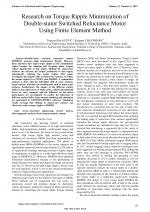| 4/2021 - 15 | View TOC | « Previous Article | Next Article » |
Research on Torque Ripple Minimization of Double-stator Switched Reluctance Motor Using Finite Element MethodDas GUPTA, T. |
| Extra paper information in |
| Click to see author's profile in |
| Download PDF |
Author keywords
electrical engineering, electric motors, electromagnetic analysis, finite element analysis, torque
References keywords
switched(20), reluctance(20), torque(13), motor(11), ripple(8), research(7), progress(6), electromagnetics(6), double(6), design(6)
Blue keywords are present in both the references section and the paper title.
About this article
Date of Publication: 2021-11-30
Volume 21, Issue 4, Year 2021, On page(s): 135 - 144
ISSN: 1582-7445, e-ISSN: 1844-7600
Digital Object Identifier: 10.4316/AECE.2021.04015
Web of Science Accession Number: 000725107100015
SCOPUS ID: 85122266863
Abstract
Double-stator switched reluctance motors (DSSRMs) possesses high torque/power density. However, these machines have high torque ripples in the commutation region because the outgoing and incoming phase torques reduce significantly in this region. Shifting the stator/rotor surfaces can increase the torque production in this region, subsequently reducing the torque ripples. This paper investigates the angular shift in stator/rotor surfaces to reduce the torque ripples in a 12/10/12 pole DSSRM. A comparative analysis is done with the individual shift of rotor surfaces, stator surfaces and then the simultaneous shift of stator-rotor surfaces. Furthermore, the impact of the different surface shifts on the radial stress of stator poles, radial and tangential forces on rotor segments and the influence on the motor performance are investigated. To predict the behaviour of different surface shifts, finite-element modeling and simulation are performed in ANSYS/MAXWELL software. Simulation results envisage that shifting in stator/rotor surfaces can effectively reduce torque ripples in DSSRM. |
| References | | | Cited By |
Web of Science® Times Cited: 0
View record in Web of Science® [View]
View Related Records® [View]
Updated 2 days, 4 hours ago
SCOPUS® Times Cited: 3
View record in SCOPUS® [Free preview]
View citations in SCOPUS® [Free preview]
[1] Dual Stator Electric Machine Equipped with Permanent Magnets on Both Stators, Chukwuemeka C. Awah,, Russian Electrical Engineering, ISSN 1068-3712, Issue 8, Volume 95, 2024.
Digital Object Identifier: 10.3103/S1068371224700846 [CrossRef]
Disclaimer: All information displayed above was retrieved by using remote connections to respective databases. For the best user experience, we update all data by using background processes, and use caches in order to reduce the load on the servers we retrieve the information from. As we have no control on the availability of the database servers and sometimes the Internet connectivity may be affected, we do not guarantee the information is correct or complete. For the most accurate data, please always consult the database sites directly. Some external links require authentication or an institutional subscription.
Web of Science® is a registered trademark of Clarivate Analytics, Scopus® is a registered trademark of Elsevier B.V., other product names, company names, brand names, trademarks and logos are the property of their respective owners.
Faculty of Electrical Engineering and Computer Science
Stefan cel Mare University of Suceava, Romania
All rights reserved: Advances in Electrical and Computer Engineering is a registered trademark of the Stefan cel Mare University of Suceava. No part of this publication may be reproduced, stored in a retrieval system, photocopied, recorded or archived, without the written permission from the Editor. When authors submit their papers for publication, they agree that the copyright for their article be transferred to the Faculty of Electrical Engineering and Computer Science, Stefan cel Mare University of Suceava, Romania, if and only if the articles are accepted for publication. The copyright covers the exclusive rights to reproduce and distribute the article, including reprints and translations.
Permission for other use: The copyright owner's consent does not extend to copying for general distribution, for promotion, for creating new works, or for resale. Specific written permission must be obtained from the Editor for such copying. Direct linking to files hosted on this website is strictly prohibited.
Disclaimer: Whilst every effort is made by the publishers and editorial board to see that no inaccurate or misleading data, opinions or statements appear in this journal, they wish to make it clear that all information and opinions formulated in the articles, as well as linguistic accuracy, are the sole responsibility of the author.





